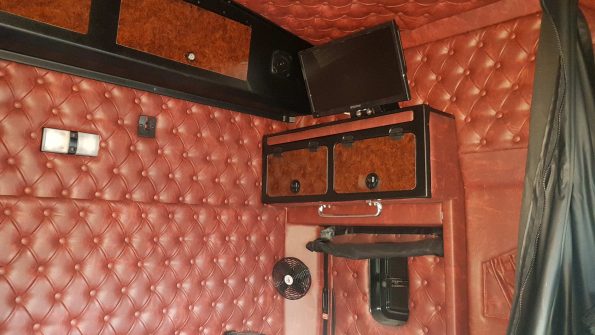Modern trucks are becoming more and more like substitutes for home, and drivers expect it. Cabs contain microwave ovens, refrigerators, gaming consoles, TVs, laptops and other electronic creature comforts that the driver can use during their rest periods; they also give the flexibility for the driver with a sleeper cab to stop anywhere rather than having to find a motel (something that does improve fuel economy as the driver can stay on the designated route).

However, all these devices use electricity and that requires the driver to idle the engine to charge and maintain the batteries that power them. This means:
- Increased fuel costs
- Increased air pollution where trucks congregate
- Noise pollution in truck stops which disrupts the sleep of drivers
A 10% reduction in idle time equates to an approximately 1% reduction in overall fuel costs plus it saves on engine wear and tear, and cuts the environmental impact of transport.
Technology solutions to reducing idle times
Battery-powered HVAC
Battery-powered heating, ventilation and air conditioning has zero emissions, doesn’t require idling, is quiet during operation, is relatively maintenance-free, can be powered externally and is easy to operate. They can be powered by batteries in the tractor unit or can be connected to an electrical power source.
However, it has a limited run time meaning it can run out of power in extreme conditions or when run for a long time, it adds weight to the truck due to the batteries, it requires a large-capacity alternator, it adds load to the engine (up to around 5kW) while recharging and it does consume fuel to recharge the batteries. Intelligent power recapture systems can reduce this, for example, only recharging the batteries by capturing braking energy.
Diesel auxiliary power units (APUs)
These can provide electrical power to the truck’s sleeper cab while the engine is off. They use between 0.3-1.5 litres per hour, depending on the load required. They can operate for as long as the truck has fuel and are more suited to extreme temperature conditions and long operating times.
However, they add weight to the vehicle, they require more maintenance than battery-powered HVAC (periodic oil and filter change) and are more expensive to install. It’s likely, though, that the cost of maintenance will be comparable or cheaper than replacing the batteries in a battery HVAC unit.
Fuel-powered air heaters
Diesel-powered heaters are used to maintain cab temperatures when the outside temperature is low, but they don’t provide air conditioning. They are easy to install and use much less fuel than idling the engine (around 0.3l/hr as opposed to 1.5-2.5l/hr when idling. They are relatively easy to install, create less noise and emissions than an idling engine, and provide high heating capacity.
Some heaters will also heat the coolant for cold conditions – not so relevant for Australia, but in places like Canada, this delivers benefits because pre-warmed engines use less fuel and can immediately provide cab heat and the ability to defrost windows.
However, they are limited in their functionality – they just heat. They may drain the batteries, depending on how they work, and they do create emissions.
Automatic engine start/stop
These systems monitor the cab’s interior temperature and turn off the engine when HVAC is not required or the batteries are charged. They can be implemented easily without any weight penalty and can be combined with other features.
However, the unexpected start or stop of an engine is disruptive to a driver’s sleep. Manufacturers need to ensure that engine start and stop is optimised as not to sound alarms and also to minimise cab rocking and vibration. Even though this is optimising the engine’s time idling, it still requires it to idle, creating more wear on the engine.
Solar panels
The technology for solar panels is ever-improving and solar panels, while rare at the moment, are becoming more popular in America. Thin, lightweight panels on the cab can be curved to match the farings. While they don’t provide enough power to run all systems, they can be used to provide a continuous trickle charge to reduce the overhead on the engine. This also improves battery life by keeping them within their optimum charge range for a longer period of time.
They’re an excellent technology for Australia’s weather. They reduce idle time and the need to start the engine, improving fuel economy. They’re convenient for the driver as it’s a passive technology and provides no disruption. They can be used on reefer trailers to minimise the time the chiller motor is running.
However, systems can be costly and they rely on a lot of sun exposure. They can interrupt the aerodynamics of the cab, increasing fuel consumption and wind noise. They need to be cleaned frequently to maintain the optimum charging capacity.
Vehicle choice and parameters
A black vehicle requires much more energy to cool on a summer’s day than a white vehicle.
Insulation in the cab reduces the temperature range. This includes windshield curtains and insulated bunk curtains to reduce sun getting in and to help maintain the interior temperature.
Engine idle parameters can be changed to automatically force idle shutdown after a certain period of time, and to control the exact engine idle speed.
There’s no one size fits all solution to reducing idle times and it’s up to the driver to manage it as efficiently as possible. Ultimately, the best idle reduction technique is to get out of the cab and stay in a motel, but as truck stops provide more and more electrification where drivers can hook up, idling may become a thing of the past.
